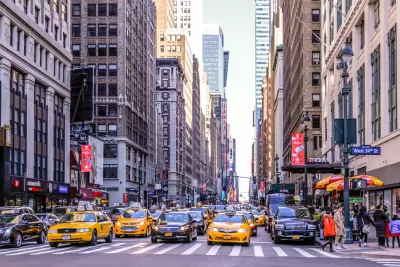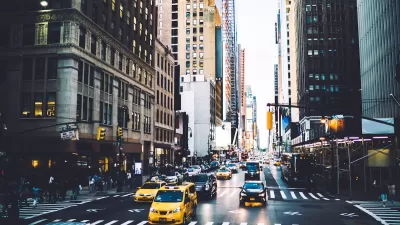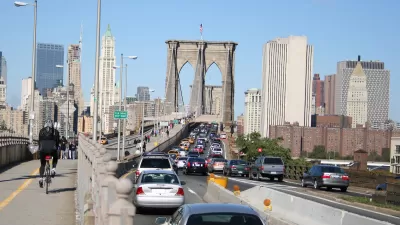Starting this summer, drivers will have to pay a toll to drive through the newly designated Congestion Relief Zone in New York City’s Central Business District.

ABC 7 Eyewitness News reports that, five years after passing in the state legislature, New York City’s controversial congestion pricing plan will go into effect on June 30. During peak hours (5 a.m.–9 p.m. on weekdays, 9 a.m.–9 p.m. on weekends), the toll structure for vehicle travel through the Congestion Relief Zone will be as follows:
- Cars: $15 toll during peak hours, and $3.75 overnight
- Trucks and buses: $24 or $36 (depending on size and purpose) and $6 and $8 overnight
- Motorcycles: $7.50 a maximum of once a day.
- Passengers of taxis, green cabs, and for-hire vehicles: $1.25 per trip
- Passengers of high-volume for-hire services like Lyft and Uber: $2.50 per trip
MTA officials say these tolls will result in 100,000 fewer vehicles entering the area every day, leading to less traffic, cleaner air, and revenue that will go toward public transit investments. ABC 7 also reports the MTA launched a portal for people to learn about eligibility for discounts or exemptions, which they can already start applying for.
The program will be the first its kind in the United States, though congestion pricing is quite popular in Europe. Opponents say the fees will burden workers, result in higher prices of goods transported into the city by truck, and simply shift congestion outside of the zone. There are also multiple pending lawsuits from small business owners and the state of New Jersey that have yet to be. Proponents say if done right, the plan could pave the way for similar congestion pricing plans across the country.
FULL STORY: MTA announces official start date for congestion pricing in New York City

Study: Maui’s Plan to Convert Vacation Rentals to Long-Term Housing Could Cause Nearly $1 Billion Economic Loss
The plan would reduce visitor accommodation by 25,% resulting in 1,900 jobs lost.

Alabama: Trump Terminates Settlements for Black Communities Harmed By Raw Sewage
Trump deemed the landmark civil rights agreement “illegal DEI and environmental justice policy.”

Why Should We Subsidize Public Transportation?
Many public transit agencies face financial stress due to rising costs, declining fare revenue, and declining subsidies. Transit advocates must provide a strong business case for increasing public transit funding.

Paris Bike Boom Leads to Steep Drop in Air Pollution
The French city’s air quality has improved dramatically in the past 20 years, coinciding with a growth in cycling.

Why Housing Costs More to Build in California Than in Texas
Hard costs like labor and materials combined with ‘soft’ costs such as permitting make building in the San Francisco Bay Area almost three times as costly as in Texas cities.

San Diego County Sees a Rise in Urban Coyotes
San Diego County experiences a rise in urban coyotes, as sightings become prevalent throughout its urban neighbourhoods and surrounding areas.
Urban Design for Planners 1: Software Tools
This six-course series explores essential urban design concepts using open source software and equips planners with the tools they need to participate fully in the urban design process.
Planning for Universal Design
Learn the tools for implementing Universal Design in planning regulations.
Smith Gee Studio
Alamo Area Metropolitan Planning Organization
City of Santa Clarita
Institute for Housing and Urban Development Studies (IHS)
City of Grandview
Harvard GSD Executive Education
Toledo-Lucas County Plan Commissions
Salt Lake City
NYU Wagner Graduate School of Public Service





























